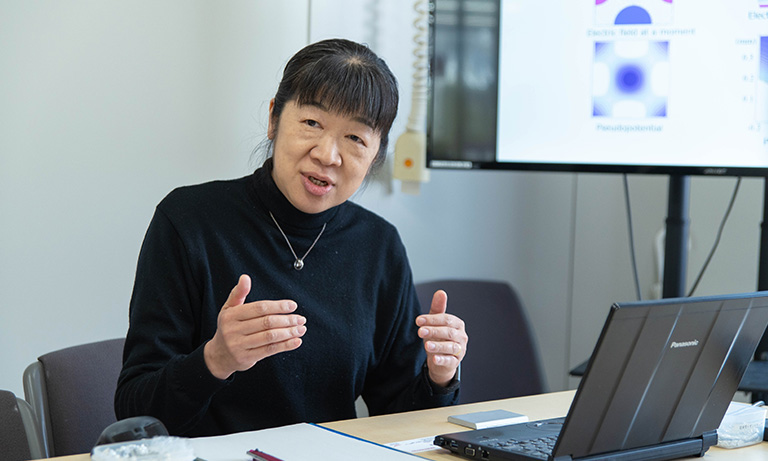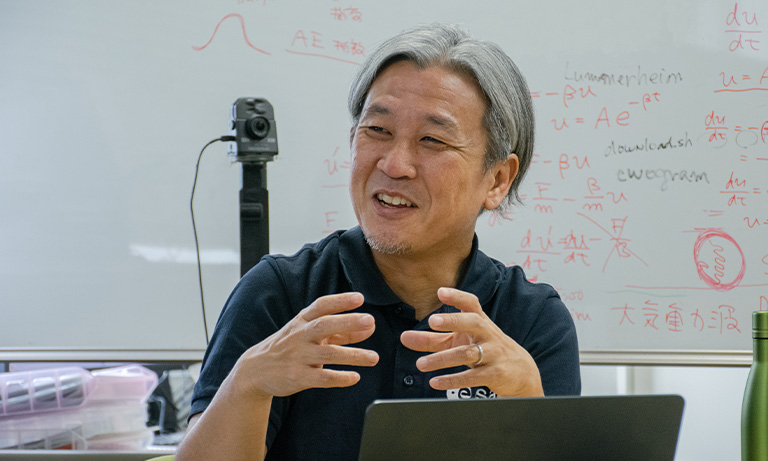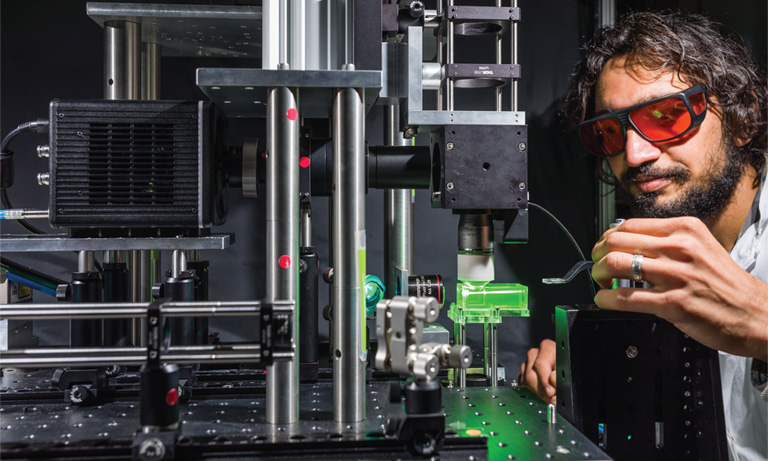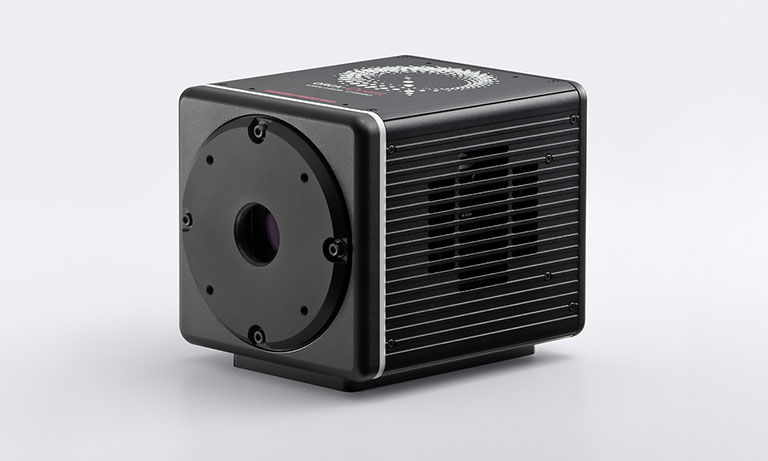Japan (JA)
国・地域を選択してください。
ORCA®-Questを用いた細胞の1分子蛍光観察
2024年7月30日公開
岐阜大学 糖鎖生命コア研究所 細胞生物物理学研究室 様は、細胞内や細胞膜上に存在する分子のメカニズムを解明するための研究をしており、1分子蛍光観察用のカメラとして2022年にORCA-Quest qCMOSⓇカメラを導入いただいております。
同研究室の鈴木 健一 様、廣澤 幸一朗 様と、2023年5月まで同研究室に所属され、現在は国立がん研究センター研究所 先端バイオイメージング研究分野 ユニット長を務める笠井 倫志 様にORCA-Questを導入した経緯やその使用感、今後の研究の展望についてインタビューを行いました。
研究について
-研究内容について教えてください。
岐阜大学 糖鎖生命コア研究所 細胞生物物理学研究室では、細胞内に存在するタンパク質や脂質分子等を1分子ずつ観察し、起きている事象の時間や頻度等の統計を取ることで分子の働く仕組みを解明することを目指しています。
分子の働く仕組みを解明するためには、分子の挙動を顕微鏡下で観察する必要があります。私たちは超高感度なカメラを使って、実験の内容に合わせて、ときには高速に、ときには高解像度に分子をイメージングし、分子の挙動や分子と分子の相互作用を解明しようとしています。また、このような観察を行うための最適な光学系の構築やイメージング手法の開発も行っています。

左から 笠井 倫志 様、 鈴木 健一 様、廣澤 幸一朗 様

1分子蛍光観察における課題
-1分子蛍光観察にはどのような課題があるのでしょうか。
1分子蛍光観察における一番の課題は、分子から発せられる信号が非常に微弱であることです。加えて、分子の挙動を観察するために高速撮像を行うことから1フレームあたりの入射信号が少なくなること、信号が微弱ゆえに通常の落射照明観察ではバックグラウンドに信号が埋もれてしまうことなど、複数の要因が重なることで、信号の検出のハードルが高くなってしまいます。バックグラウンドを低減させるために、1分子蛍光観察では全反射照明蛍光顕微鏡(TIRF)を使用することが一般的ですが、最終的に信号をデータとして出力するカメラ側の読み出しノイズを下げることもまた重要となります。
このように1分子蛍光観察には様々な課題がありますが、この課題を解決する方法として一般的なのは、微弱な信号を増倍して検出することができるEM-CCDカメラや、I.I.(イメージインテンシファイア) とsCMOSカメラ(科学計測用CMOSカメラ)を組み合わせて撮影を行うことでした。しかし、EM-CCDカメラやI.I.は信号を増倍する過程で信号のゆらぎを発生させてしまうため、信号の定量性が低くなることに加え、分解能も低下するという欠点があります。私達の研究室では近年1分子の超解像イメージングも行っておりますが、ゆらぎによる分解能の低下は超解像画像の画質低下につながるため、I.I.等を使わずに信号を検出できるカメラを必要としていました。

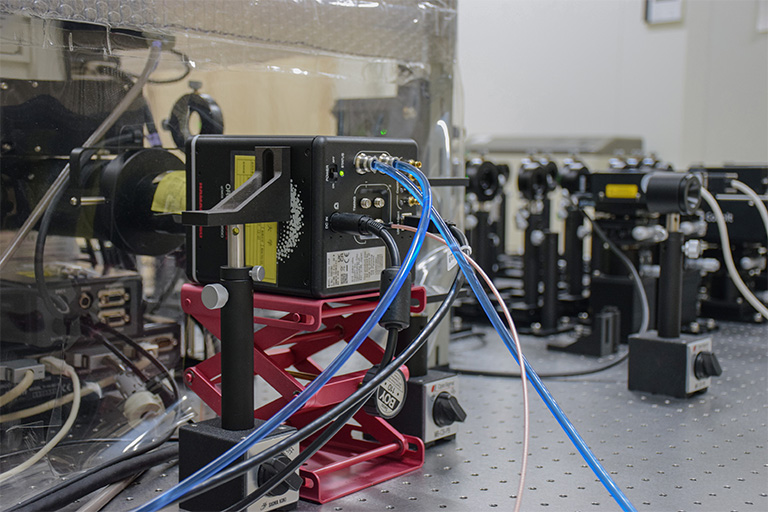
ORCA-Quest 導入の決め手

-ORCA-Questの導入に至った理由や決め手を教えてください。
ORCA-Questを導入した一番の決め手は、ORCA-Questをお借りした際に取得した画像を見て一目でノイズの低下による画質の向上がこれまでのカメラとは格段に違うと実感できたことです。もちろんスペックシートを見てノイズが下がっていることはわかっていましたが、実際に出力された画像を目で見てすぐに明らかな違いが実感できるほどの性能の向上には、「カメラの性能もここまで来たか」と感じたことを覚えています。
私達の研究室では、ORCA-Quest以前のORCA-Flash4.0やORCA-Fusion等も使用しています。これらのカメラも非常に高感度なカメラではあるのですが、私達が必要とするフレームレートではやはり1分子からの信号が弱く、カメラ単体では満足のいく画像が得られませんでした。そのため、これらのsCMOSカメラとI.I.を組み合わせて撮影をしていました。しかし、ORCA-Questではカメラ単体で撮影をしても満足のいく1分子蛍光画像が取得できました。これによって1分子のトラッキングや、超解像画像作成時のクオリティを向上させることができると考え、導入に至りました。
現在はORCA-QuestとI.I.+sCMOSカメラを実験によって使い分けています。非常に高速な撮影を行う必要があるケースでは、感度面でI.I.+sCMOSカメラの組み合わせに軍配が上がることもありますが、多くのケースではORCA-Questで満足のいく画像を取得することができています。
撮像例
チャイニーズハムスター卵巣由来のCHO細胞内に、蛍光タンパク質mStayGoldで標識したケモカイン受容体CXCR4を発現させ、ORCA-Questを用いて1分子蛍光観察を行いました。
スキャンモード:Standard scan
フレームレート:40 フレーム/秒(1024 × 1024)
スキャンモード:Ultra quiet scan
フレームレート:40 フレーム/秒(512 × 512)
画像提供:国立研究開発法人 国立がん研究センター研究所 先端バイオイメージング研究分野 笠井 倫志 様
今後の研究展望
-今後の研究の展望を教えてください。
今後の研究の展望としては、主に以下の2つの撮影手法を用いて研究を発展させていきたいと考えています。
1.多波長化
2.三次元超解像観察
多波長化に関して、私達は現在主に2波長で1分子蛍光観察を行っていますが、これを3波長、4波長と増やしていきたいと考えていきます。例えば3波長同時イメージングを行えるようになると、そのうちの2波長は分子の挙動を観察するために使用し、残りの1波長は超解像画像の撮影のために使用するというように、2種類のイメージングを同時に行うことができるようになります。これにより、現在よりもさらに複雑な分子の解析ができるようになると期待しています。
三次元超解像観察に関して、現在は主に細胞膜の表面に存在する分子の挙動を観察していますが、三次元超解像観察によって膜の内側も同時にイメージングすることにより、そこに存在する小胞体やゴルジ体等と分子の相互作用を観察することができるようになります。これにより膜上で起きている現象に膜内の小胞体やゴルジ体等がどのように関わっているのか、また膜上で起きている現象の情報がどのように膜内に伝わっているのかということを解明できる可能性があります。
三次元超解像画像を撮影する方法はいくつかありますが、我々の研究室ではシリンドリカルレンズを用いた手法を使用しています。この手法で三次元超解像画像を取得するためには、二次元画像の分子の形から分子のZ軸方向の位置情報を逆算する必要があります。その際、ただ分子が光っていることがわかるだけでは十分でなく、その分子の形がどのようになっているかわかるレベルの分解能が必要になります。I.I.を使用すると感度が上がる半面、分解能が低下してしまい分子の形がぼやけてしまうため、超解像画像の作成時に画質の低下を及ぼしていました。今回、ORCA-Questを導入したことによってI.I.を使わなくてもよくなったため、この課題が解決できました。また、I.I.によるゆらぎがなくなったことで輝度の定量性も向上しましたが、これも超解像画像を構築する際の画質の向上につながっています。ORCA-Questは、私達の研究のさらなる発展を支えるカメラだと思っています。

国立がん研究センター研究所 先端バイオイメージング研究分野について
2023年6月 国立がん研究センター研究所にて、鈴木健一 氏を分野長、笠井倫志 氏をユニット長とする先端バイオイメージング研究分野が新たに開設されました。
同研究所では、岐阜大学 糖鎖生命コア研究所と同じ構成の顕微鏡システムを使って、主に1分子蛍光観察を用いてがん細胞のシグナル制御機構やシグナル伝達機構等を解明することを目的とした研究を進めています。

研究者プロフィール

鈴木 健一
岐阜大学 糖鎖生命コア研究所 細胞生物物理学研究室 教授
国立研究開発法人 国立がん研究センター研究所 先端バイオイメージング研究分野 分野長
1996年11月 京都大学大学院工学研究科合成・生物化学専攻 博士課程
1997年1月 博士 (工学) (京都大学)
1996年11月 デューク大学メディカルセンター Michael P. Sheetz研究室研究員
1999年2月 ERATO楠見膜組織能プロジェクト研究員
2005年4月 京都大学再生医科学研究所 特任助手
2008年10月 科学技術振興機構さきがけ専任研究者
2011年4月 京都大学物質-細胞統合システム拠点准教授、兼、インド幹細胞・再生医科学研究所 客員准教授
2017年4月 岐阜大学 生命の鎖統合研究センター 教授
2021年1月 岐阜大学 糖鎖生命コア研究所 細胞生物物理学研究室 教授
2023年4月 国立がん研究センター研究所 先端バイオイメージング研究分野 分野長兼任

笠井 倫志
国立研究開発法人 国立がん研究センター研究所 先端バイオイメージング研究分野 ユニット長
星薬科大学 客員講師
2005年3月 名古屋大学理学研究科生命理学専攻 博士課程
2005年4月 国立研究開発法人 科学技術振興機構国際共同研究事業(ICORP)膜機構プロジェクト 研究員
2010年4月 京都大学 物質-細胞統合システム拠点 特定研究員
2011年4月 京都大学 再生医学研究所 助教
2016年10月 京都大学 ウイルス・再生医科学研究所 助教
2021年4月 岐阜大学 糖鎖生命コア研究所 特任准教授
2023年6月 国立がん研究センター研究所 先端バイオイメージング研究分野 ユニット長
2024年4月 星薬科大学 客員講師兼任

廣澤 幸一朗
岐阜大学 糖鎖生命コア研究所 細胞生物物理学研究室 研究員
2010年3月 京都大学工学研究科マイクロエンジニアリング専攻 博士課程
2010年4月 京都大学 物質-細胞統合システム拠点 (iCeMS) 研究員
2017年4月 岐阜大学生命の鎖統合研究センター 研究員
2021年1月 現職
※ 本ページに掲載している内容は、2023年9月の取材時点のものです。
関連製品
ORCA-Quest 2は、ORCA-Questの後継機として極めて低ノイズなスキャンモードにおける読み出し速度の高速化や紫外領域での感度向上を実現。更なる進化を遂げた新たなqCMOSカメラです。
その他のお客様導入事例
- Confirmation
-
It looks like you're in the . If this is not your location, please select the correct region or country below.
You're headed to Hamamatsu Photonics website for JP (Japanese). If you want to view an other country's site, the optimized information will be provided by selecting options below.
In order to use this website comfortably, we use cookies. For cookie details please see our cookie policy.
- Cookie Policy
-
This website or its third-party tools use cookies, which are necessary to its functioning and required to achieve the purposes illustrated in this cookie policy. By closing the cookie warning banner, scrolling the page, clicking a link or continuing to browse otherwise, you agree to the use of cookies.
Hamamatsu uses cookies in order to enhance your experience on our website and ensure that our website functions.
You can visit this page at any time to learn more about cookies, get the most up to date information on how we use cookies and manage your cookie settings. We will not use cookies for any purpose other than the ones stated, but please note that we reserve the right to update our cookies.
1. What are cookies?
For modern websites to work according to visitor’s expectations, they need to collect certain basic information about visitors. To do this, a site will create small text files which are placed on visitor’s devices (computer or mobile) - these files are known as cookies when you access a website. Cookies are used in order to make websites function and work efficiently. Cookies are uniquely assigned to each visitor and can only be read by a web server in the domain that issued the cookie to the visitor. Cookies cannot be used to run programs or deliver viruses to a visitor’s device.
Cookies do various jobs which make the visitor’s experience of the internet much smoother and more interactive. For instance, cookies are used to remember the visitor’s preferences on sites they visit often, to remember language preference and to help navigate between pages more efficiently. Much, though not all, of the data collected is anonymous, though some of it is designed to detect browsing patterns and approximate geographical location to improve the visitor experience.
Certain type of cookies may require the data subject’s consent before storing them on the computer.
2. What are the different types of cookies?
This website uses two types of cookies:
- First party cookies. For our website, the first party cookies are controlled and maintained by Hamamatsu. No other parties have access to these cookies.
- Third party cookies. These cookies are implemented by organizations outside Hamamatsu. We do not have access to the data in these cookies, but we use these cookies to improve the overall website experience.
3. How do we use cookies?
This website uses cookies for following purposes:
- Certain cookies are necessary for our website to function. These are strictly necessary cookies and are required to enable website access, support navigation or provide relevant content. These cookies direct you to the correct region or country, and support security and ecommerce. Strictly necessary cookies also enforce your privacy preferences. Without these strictly necessary cookies, much of our website will not function.
- Analytics cookies are used to track website usage. This data enables us to improve our website usability, performance and website administration. In our analytics cookies, we do not store any personal identifying information.
- Functionality cookies. These are used to recognize you when you return to our website. This enables us to personalize our content for you, greet you by name and remember your preferences (for example, your choice of language or region).
- These cookies record your visit to our website, the pages you have visited and the links you have followed. We will use this information to make our website and the advertising displayed on it more relevant to your interests. We may also share this information with third parties for this purpose.
Cookies help us help you. Through the use of cookies, we learn what is important to our visitors and we develop and enhance website content and functionality to support your experience. Much of our website can be accessed if cookies are disabled, however certain website functions may not work. And, we believe your current and future visits will be enhanced if cookies are enabled.
4. Which cookies do we use?
There are two ways to manage cookie preferences.
- You can set your cookie preferences on your device or in your browser.
- You can set your cookie preferences at the website level.
If you don’t want to receive cookies, you can modify your browser so that it notifies you when cookies are sent to it or you can refuse cookies altogether. You can also delete cookies that have already been set.
If you wish to restrict or block web browser cookies which are set on your device then you can do this through your browser settings; the Help function within your browser should tell you how. Alternatively, you may wish to visit www.aboutcookies.org, which contains comprehensive information on how to do this on a wide variety of desktop browsers.
5. What are Internet tags and how do we use them with cookies?
Occasionally, we may use internet tags (also known as action tags, single-pixel GIFs, clear GIFs, invisible GIFs and 1-by-1 GIFs) at this site and may deploy these tags/cookies through a third-party advertising partner or a web analytical service partner which may be located and store the respective information (including your IP-address) in a foreign country. These tags/cookies are placed on both online advertisements that bring users to this site and on different pages of this site. We use this technology to measure the visitors' responses to our sites and the effectiveness of our advertising campaigns (including how many times a page is opened and which information is consulted) as well as to evaluate your use of this website. The third-party partner or the web analytical service partner may be able to collect data about visitors to our and other sites because of these internet tags/cookies, may compose reports regarding the website’s activity for us and may provide further services which are related to the use of the website and the internet. They may provide such information to other parties if there is a legal requirement that they do so, or if they hire the other parties to process information on their behalf.
If you would like more information about web tags and cookies associated with on-line advertising or to opt-out of third-party collection of this information, please visit the Network Advertising Initiative website http://www.networkadvertising.org.
6. Analytics and Advertisement Cookies
We use third-party cookies (such as Google Analytics) to track visitors on our website, to get reports about how visitors use the website and to inform, optimize and serve ads based on someone's past visits to our website.
You may opt-out of Google Analytics cookies by the websites provided by Google:
https://tools.google.com/dlpage/gaoptout?hl=en
As provided in this Privacy Policy (Article 5), you can learn more about opt-out cookies by the website provided by Network Advertising Initiative:
http://www.networkadvertising.org
We inform you that in such case you will not be able to wholly use all functions of our website.
Close










